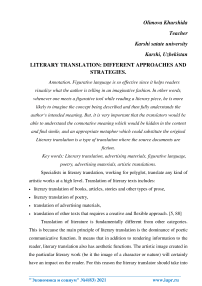Literary translation: different approaches and strategies
Автор: Olimova Kh.
Журнал: Экономика и социум @ekonomika-socium
Рубрика: Основной раздел
Статья в выпуске: 4-1 (83), 2021 года.
Бесплатный доступ
Figurative language is so effective since it helps readers visualize what the author is telling in an imaginative fashion. In other words, whenever one meets a figurative tool while reading a literary piece, he is more likely to imagine the concept being described and then fully understands the author‘s intended meaning. But, it is very important that the translators would be able to understand the connotative meaning which would be hidden in the content and find simile, and an appropriate metaphor which could substitute the original Literary translation is a type of translation where the source documents are fiction.
Literary translation, advertising materials, figurative language, poetry, artistic translations
Короткий адрес: https://sciup.org/140259054
IDR: 140259054
Список литературы Literary translation: different approaches and strategies
- Мусаев Қ. Бадиий таржима ва нутқ маданияти - Т., 1996.
- Мусаев Қ. Лексико-фразеологические вопросы художественного перевода. - Т.: "Ўқитувчи", 1980.
- Rakhmatullayev Sh. Current literary Uzbek language.-Tashkent, 2006
- Саломов Ғ. Таржима назарияси асослари. - Ташкент, 1970
- Саломов Ғ. Тил ва таржима. - Тошкент: "Фан", 1966
- Муминов А.М. English Lexicology. - Т.: 2006. Tuxtaxodjayeva N.A. "Badiiy tarjimada lingvokulturalarning ifodalanishi" (ingliz va o'zbek tillari misolida). Фан док.дисс. автореф. - Т., 2017
- Niyozmetova P., Nurmatova M.P. "The classification of English and Uzbek phraseological units: their similarities and differences". Молодой ученый. 2016. №6
- Бушуй А.М. Текст как лингвистический объект // Преподавание языка и литературы. - Тошкент, 2003. - № 4.


